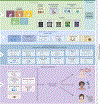Integrative metabolomics science in Alzheimer's disease: Relevance and future perspectives
- PMID: 37343679
- PMCID: PMC12450062
- DOI: 10.1016/j.arr.2023.101987
Integrative metabolomics science in Alzheimer's disease: Relevance and future perspectives
Abstract
Alzheimer's disease (AD) is determined by various pathophysiological mechanisms starting 10-25 years before the onset of clinical symptoms. As multiple functionally interconnected molecular/cellular pathways appear disrupted in AD, the exploitation of high-throughput unbiased omics sciences is critical to elucidating the precise pathogenesis of AD. Among different omics, metabolomics is a fast-growing discipline allowing for the simultaneous detection and quantification of hundreds/thousands of perturbed metabolites in tissues or biofluids, reproducing the fluctuations of multiple networks affected by a disease. Here, we seek to critically depict the main metabolomics methodologies with the aim of identifying new potential AD biomarkers and further elucidating AD pathophysiological mechanisms. From a systems biology perspective, as metabolic alterations can occur before the development of clinical signs, metabolomics - coupled with existing accessible biomarkers used for AD screening and diagnosis - can support early disease diagnosis and help develop individualized treatment plans. Presently, the majority of metabolomic analyses emphasized that lipid metabolism is the most consistently altered pathway in AD pathogenesis. The possibility that metabolomics may reveal crucial steps in AD pathogenesis is undermined by the difficulty in discriminating between the causal or epiphenomenal or compensatory nature of metabolic findings.
Keywords: Alzheimer’s disease; Amino acids; Biomarkers; Lipids; Metabolomics; Systems biology.
Copyright © 2023 Elsevier B.V. All rights reserved.
Conflict of interest statement
Declaration of Competing Interest EE is the unique owner of 2E Science, a for-profit private scientific company. Neither EE nor 2E Science have any commercial interest or financial tie in relation with this article. BPI is an employee at Chiesi Farmaceutici. He is listed among the inventors of a number of Chiesi Farmaceutici’s patents of anti-Alzheimer drugs. SL, RG-D, SL-O, AG-D, HM, JM-H, AL, DC, VT, LL, MS, MC-C, JM, LL, MM, AS-L, and RN declare that they have no conflict of interest.
Figures





References
-
- Abdelnur P. v, Caldana C, Martins MCM, 2014. Metabolomics applied in bioenergy. Chemical and Biological Technologies in Agriculture 1, 22. 10.1186/s40538-014-0022-0 - DOI
-
- Akyol S, Ugur Z, Yilmaz A, Ustun I, Gorti SKK, Oh K, McGuinness B, Passmore P, Kehoe PG, Maddens ME, Green BD, Graham SF, 2021. Lipid Profiling of Alzheimer’s Disease Brain Highlights Enrichment in Glycerol(phospho)lipid, and Sphingolipid Metabolism. Cells 10, 2591. 10.3390/cells10102591 - DOI - PMC - PubMed
-
- Alawode DOT, Heslegrave AJ, Ashton NJ, Karikari TK, Simrén J, Montoliu-Gaya L, Pannee J, ÓConnor A, Weston PSJ, Lantero-Rodriguez J, Keshavan A, Snellman A, Gobom J, Paterson RW, Schott JM, Blennow K, Fox NC, Zetterberg H, 2021. Transitioning from cerebrospinal fluid to blood tests to facilitate diagnosis and disease monitoring in Alzheimer’s disease. J Intern Med 290, 583–601. 10.1111/joim.13332 - DOI - PMC - PubMed
Publication types
MeSH terms
Substances
Grants and funding
LinkOut - more resources
Full Text Sources
Medical
Research Materials

